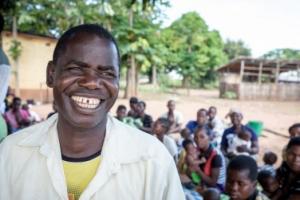Committed to improve child health: Stories from the field, Zambezia, Mozambique 25 March 2015.
“When a child is crying, we have to take it to the health centre to do tests, and see which is the illness, because the health centre is where all the needed care is available…”.
Each time a women breaks out singing; the rest of the group quickly follows through.
“We have to take care of the children because they are the richness of tomorrow. We cannot give water to the baby, we have to give breast milk…”
The women are sitting outside under a big tree at Dachudua Health Centre in Milange District, 63 kilometres from the district capital. Child health activist, Fernando Chemusse claps along to lead the songs after the women initiate them, while medical the staff prepare a scale, vaccinations and vitamin A. After five or six songs, Fernando starts helping the medical staff with the last preparations before the weighing and vaccination begin.
The songs are teaching women about health and how to take care of their children, explains Fernando. They learn the songs because we also sing them in the communities. The women who initiate the songs have priority in the line.
Fernando holds a WHO/Ministry of Health folder closely called: “Atenção integrada às doenças da infância para agentes comunitários de saúde”. Integrated Management of Childhood Illness (IMCI) is an integrated approach to child health that focuses on the well-being of the whole child. It aims to reduce death, illness and disability, and to promote improved growth and development among children under five years of age. IMCI includes both preventive and curative elements that are implemented by families and communities as well as by health facilities.
I have been an activist for three years, says Fernando, before that I was a health volunteer. I am member of the local community health council. It was also the council who nominated me to become a child health activist.
The council has 25 members including activists, volunteers and traditional birth attendants. They all meet once a month to discuss health in the communities and the content of health education sessions.
I am responsible for child health in five communities; Shiringe, Majone, Leveleve, Gerenge and Javijavi. I visit all communities regularly to find out about the health of the children in each one. I go from door to door and check children for basic symptoms.
Because of his connection to the communities and local language skills, Fernando works as an intermediate between Dachudua health centre and his communities of responsibility. He teaches parents to recognise symptoms and makes sure that children receive the appropriate care at facility level.
When I identify a child with a health problem, I fill out a referral slip with images indicating the problem, I give it to the mother and sometimes I accompany mother and child here to Dachudua health centre. After maximum six days, I will visit the same family again to know if the child is better.
To make sure that children receive quality care when arriving at the health centre, medical staff have been trained in integrated management of childhood diseases. Activists have also received regular training on other health-related topics.
Other than the training I did to become an IMCI activist, I did training on family planning about a year ago so I can do health education sessions and inform when visiting homes.
The MDG 4&5 project aims to improve maternal and child health with particular focus on Zambezia province. Four UN Agencies work together to make this project happen: WHO, UNFPA, UNICEF and WFP with funding from the Canadian Department of Foreign Affairs, Trade and Development. One of the goals is to increase demand for and improve quality of skilled care before, during and after childbirth.



